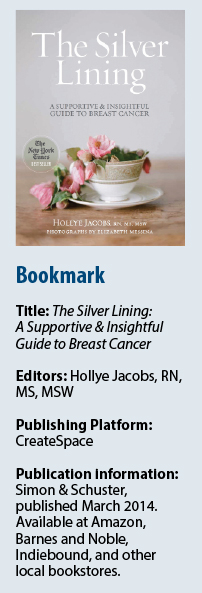Title: The Silver Lining: A Supportive & Insightful Guide to Breast Cancer
Editors: Hollye Jacobs, RN, MS, MSW
Publishing Platform: CreateSpace
Publication information: Simon & Schuster, published March 2014. Available at Amazon, Barnes and Noble, Indiebound, and other local bookstores.
Over the past several decades the oncology community has made notable advances in cancer treatment. But there’s also been a hard-fought culture change in the approach to the continuum of care. The phrase “treat the whole patient, not just the tumor,” is often heard in the oncology vernacular. But that wasn’t always so. Like many advances in oncology, the emerging supportive care disciplines of psychosocial care and integrative oncology were the results of decades of work and struggle by many dedicated pioneers such as Jimmie Holland, MD, and Barrie Cassileth, MS, PhD, of Memorial Sloan Kettering Cancer Center.
Supportive care disciplines in oncology have also attracted people interested in writing about this important issue, such as palliative care nurse, Hollye Jacobs, RN, MS, MSW. In her new book, The Silver Lining: A Supportive & Insightful Guide to Breast Cancer, Ms. Jacobs not only brings her insight as a palliative care nurse to her narrative, but also as a breast cancer survivor. As often mentioned, the shelves are overflowing with books on cancer, from dense scientific tomes, histories, memoirs, and survivorship books. Thus, writing a book that doesn’t get lost among other similar titles is a daunting task. Ms. Jacobs solves the problem of being noticed by having written a glossy, coffee-table-style book replete with splendid photographs by award-winning photographer, Elizabeth Messina. At first, pairing beautiful and at times provocative full-color photographs with a guide to surviving breast cancer might seem incongruous, but, for the most part, it works.
Self-Discovery Through Illness
In the introduction, the author describes herself as a happily married wife, mother, palliative care nurse, and social worker living in Santa Barbara, California. She also depicts the shock of her cancer diagnosis, since she was a “healthy, happy, vegan-eating, marathon-running thirty-nine-year-old, with no family history of breast cancer.”
All books need to be about something, and Ms. Jacobs describes her book as “my journey of self-discovery through illness, finding silver linings in life, and celebrating grace and positive thinking from the time of my breast cancer diagnosis through treatment, recovery, and ultimately the celebration of life after breast cancer.”
The book is that, but fortunately it is a lot more. One of the most appealing parts of Ms. Jacobs’ book is its architecture. Each of the nine chapters in the table of contents has its own descriptive photograph, offering artistic windows into the forthcoming content. Moreover, each chapter is subdivided into three sections: Memoir, The Silver Lining, and Practical Matters.
The first section Memoir is the chronicle of the author’s experiences, offering her highs and lows from the terrifying diagnosis on through treatment and survivorship. The second section, Silver Linings, gives the reader practical sources of hope and inspiration, both of which are essential components of the healing process. The Practical Matters section of each chapter pertains to all things necessary to know during every phase of therapy. In this section, Ms. Jacobs’ experience, as a palliative care nurse is evident. This section is also formatted in easy-to-read and well-written bulleted lists. This type of “practical advice” for patients is certainly not new, but here you’ll find advice that is more complete and thoughtful than in most books on the market, making this part a special gem for breast cancer patients and their loved ones.
Still another value-added part of the book’s interesting format is found within the Memoir section of each chapter called “Lifelines.” These are call-outs of sorts that are personal suggestions from the author herself, both personal as well as professional, to, as she writes, “Prevent some of the calamities (oh yes, calamities) that I faced.” For example: Lifeline—Cleaning all foods will help prevent infection, especially in an immune-system-compromised body.
Focus on Need for Improved Pain Management
In chapter 3, one of the book’s strongest, the author discusses recovery issues following breast surgery. In a compelling section of this chapter, Ms. Jacobs describes her experience in the recovery room following a double mastectomy. “I remember nothing about recovery or room transfer. Instead, I woke up in a pitch-black room, nearly glued to the ceiling with pain. Pain the like of which I had never experienced before.” As it turned out, the nurses in the recovery room had neglected to turn on the pump, after loading it with a cartridge of hydromorphone.
But there’s more here, valuable information for every cancer patient and their caregivers. The nurses in the recovery room were not adequately trained in pain management. Moreover, the oncology community still faces a serious problem in the undertreatment of cancer pain. Being a palliative care nurse, Ms. Jacobs correctly points out in vivid, unvarnished language why pain management must be a priority with everyone in the cancer care continuum. She writes, “Are you wondering why I’m so obsessed with pain management? Well, because pain is bad. Pain interrupts sleep. Pain decreases mobility. Pain decreases endurance and energy…pain can also impair the immune response and your subsequent ability to get better…virtually nothing positive can resume until physical pain is managed.”
There’s more about pain, and every word is needed. This is an area the oncology community needs to work harder on, and the author is spot on with her criticism and solid advice. It’s also a clarion call to all cancer patients to be well educated about their disease, treatment, and survivorship issues. Ms. Jacobs stresses a vital message throughout the book about the need for a true doctor-patient partnership.
Stunning Photography
The photographs by Elizabeth Messina are nothing short of beautiful, in a tasteful and understated way. But still, arty photographs? The author addresses that, too.
“You may be wondering: What’s up with these photographs? We believe that these beautiful images will bring peace and comfort on days that you don’t have the energy to read…our intention is not to make the breast cancer experience beautiful, but rather to add some beauty to the experience.”
One of the most telling images is a black-and-white shot of the author bare from the waist up, after breast reconstruction. Looking at that photo, it’s well worth noting that there was a time in our not-so-distant past when women with breast cancer were discouraged from mentioning it in public. This is an interesting, informative, and elegantly constructed book for patients and their doctors. ■
For more information, visit www.thesilverpen.com.



